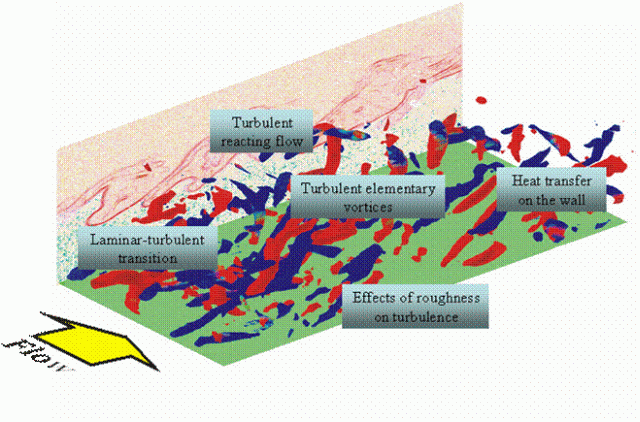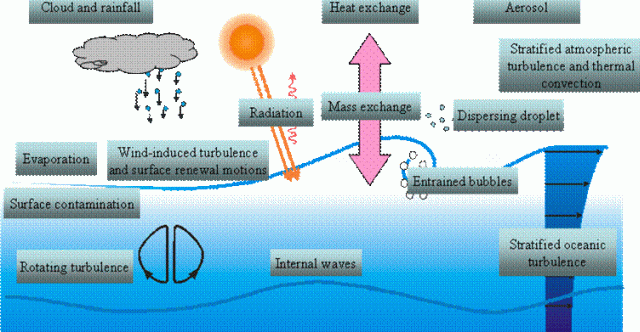
|

|

|

|

|

|
| Satoru Komori |
| Complex Fluid Mechanics Group Leader |
| Department of Mechanical Engineering and Science |
| Graduate School of Engineering |
We live in an environment surrounded by fluids and encounter a variety of fluid flow phenomena on a daily basis. The scales of these fluid flows vary widely in the range from microns, as seen in the blood flow of living organisms, MEMS (Micro Electromechanical System) or microreactors, to meters in industrial equipment, and to km in the atmosphere or ocean. These fluid flows are caused not only by pressure force, but also by buoyancy, gravitation, centrifugal force, electromagnetic force and other external forces. In most fluid flows, not only momentum transfer, but also heat and mass transfer, chemical reactions and various other factors are involved, which make the fluid flow phenomena highly complex. Accordingly, to understand fluid dynamics in practical flow fields and develop useful fluid technology, we have to identify each of the various factors that constitute complex fluid phenomena and study their basic properties.
Our fluid mechanics research group in the 21st century COE program "Mathematical Modeling and Design Theory of Dynamic Functional Mechanical Systems", involves eight laboratories which belong to three different departments, Mechanical Engineering, Physics and Mechanical Engineering and Aeronautics and Astronautics, and our group together forms a collaboration devoted to the study and modeling of complex fluid flow phenomena. Each member of the group promotes unique fundamental research on complex fluid phenomena and publishes his/her research results through international leading journals and academic exchange. The group also develops two research projects, Turbulence Control System and Atmosphere-Ocean System, related to complex fluid flow phenomena that go beyond the framework of conventional fluid and thermal engineering research. Such themes are most challenging for our mechanical engineers who have a deep knowledge of simultaneous transfer of momentum, heat and mass in fluids. Both researchers in this core group and other visiting researchers from Japan and abroad will take parts in the exciting projects.
Our fluid mechanics research group is not simply a group of researchers engaged in special research projects. Our ultimate objective is to become a legitimate internationally recognized center of excellence for fluid mechanics research that retains a high level of researchers or scientists and provides the latest advanced information of fundamental researches to the world, as well as to invite many excellent researchers from both Japan and abroad. To attain this objective we set the following three targets:
Current research subjects of the eight laboratories that belong to the complex fluid mechanics research group are summarized as follows:
To exploit maximally the research specialties of each laboratory, our group has focused on two subjects: 1) development of turbulence control system, and 2) modeling of atmosphere-ocean system. These two projects are briefly introduced below.
For the optimum design of transportation machines such as airplanes, vehicles, and ships and energy equipment such as gas turbines and chemical reactors, it is important to fully understand the turbulence structure near the wall and to develop technology for controlling this turbulence. Particularly important are reduction of the friction drag acting the transportation machines, the efficient promotion of mixing and reaction in reactors, and the control of heat exchange rate in combustors. Resolution of these issues requires clarification of complex fluid flow phenomena associated with heat and mass transfer. Furthermore, surface treatment of the wall at the nano-level may be required to reduce friction drag or to promote heat and mass transfer. Accordingly, the main focus of our project is on the elucidation of these complex turbulence phenomena and integration of all the information obtained through such investigations, to provide knowledge useful for developing turbulence control technology. Therefore, this project is clearly distinct from the empirical trial and error researches currently used to develop such systems. Figure 1 illustrates the specific aspect of turbulence control system which some members of our fluid mechanics research group are focusing.

Global warming is mainly caused by carbon dioxide (CO2) generated in the course of fossil-fuel burning. It is an important issue for environmental researchers to precisely forecast the greenhouse effect, resulting in the promotion of large-scale national projects such as the "Earth Simulator". This global warming forecast has been conducted using a General Circulation Model (GCM), composed of various sub-models that represent the complex turbulent transport phenomena associated with heat, mass and momentum transfer occurring in atmosphere and oceans. The numerical simulation by the GCM based on the sub-models provides future scenarios on global warming. This simulation method can be used not only for this application, but also for forecasting several unusual climate changes such as localized torrential downpours, droughts, heat island and so on. However, the specific physical sub-models used for the current GCM have not been fully examined, and so there remains a risk of significant errors in forecasting global warming and local climate changes. The reliability of the sub-models for estimating heat, mass and momentum transfer at the air-sea and air-land boundaries is especially poor. When we look at the method used in the GCM for estimating exchange rate of mass (CO2, etc.) between the atmosphere and ocean, for example, heat and mass flux is expressed simply by the product of concentration difference between the atmosphere and ocean and the mass transfer velocity (referred to as the mass transfer coefficient in engineering field). The mass transfer velocity is, however, strongly influenced by several factors, including the turbulence structure near the air-sea interface, the density stratification, the entrained air bubbles and dispersed droplets due to intense wave breaking, surface contamination and others. If the transfer velocity model does not accurately express these effects, an estimate of mass exchange rate between the atmosphere and ocean may easily result in the error of about 1 PgC per year. That is, even if we integrate the local mass flux over the whole ocean surface and evaluate the global mass exchange rate between the atmosphere and ocean, the predicted scenario for global warming will be far from reality, unless the sub-models used as their bases are reliable. Furthermore, to estimate the mass exchange rate between the atmosphere and land is even far more difficult than that between the atmosphere and ocean, due to the influence of land-based vegetation. We can only indirectly estimate the land uptake by taking the mass balance of carbon between ocean uptake and absorption into atmosphere. Therefore, it is of great importance to precisely estimate the atmosphere-ocean flux, in order to accurately forecast the global warming.

Currently, researches related to such global warming forecasts are considered to fall under the category of atmospheric or marine science, and only geophysicists who specialize in meteorology or oceanography are conducting such studies. However, complex fluid transport phenomena in atmospheric and oceanic turbulence are important research subjects that can and should be addressed by mechanical engineers, who can easily treat simultaneous momentum, heat and mass transfer. A number of phenomena, including heat and mass transfer between atmosphere and ocean and between atmosphere and land, turbulent heat and mass transfer with evaporation and radiation in the atmosphere and ocean, the effects of clouds, rain and aerosols on heat and mass transfer, the density stratification effects on turbulent eddy motions in the atmosphere and ocean, interact with one another, together composing the complex atmospheric and oceanic system. Our fluid mechanics group members are specialized at investigating these complex fluid flow phenomena. To create a reliable model for this atmosphere and ocean system, we will study in detail the underlying turbulence and transport phenomena using the most advanced techniques available in the present thermal and fluid engineering. The first two or three years of our project will be devoted to the study on the heat and mass transfer mechanism between the atmosphere and ocean. The project developing component models on which a more reliable climate model can be built is clearly distinctive in comparison to the current research underway, which only conducts global numerical forecasts based on unreliable component sub-models. Figure 2 illustrates the elemental fluid flow phenomena in the atmosphere and the ocean system that individual laboratories of our complex fluid mechanics research group can treat.